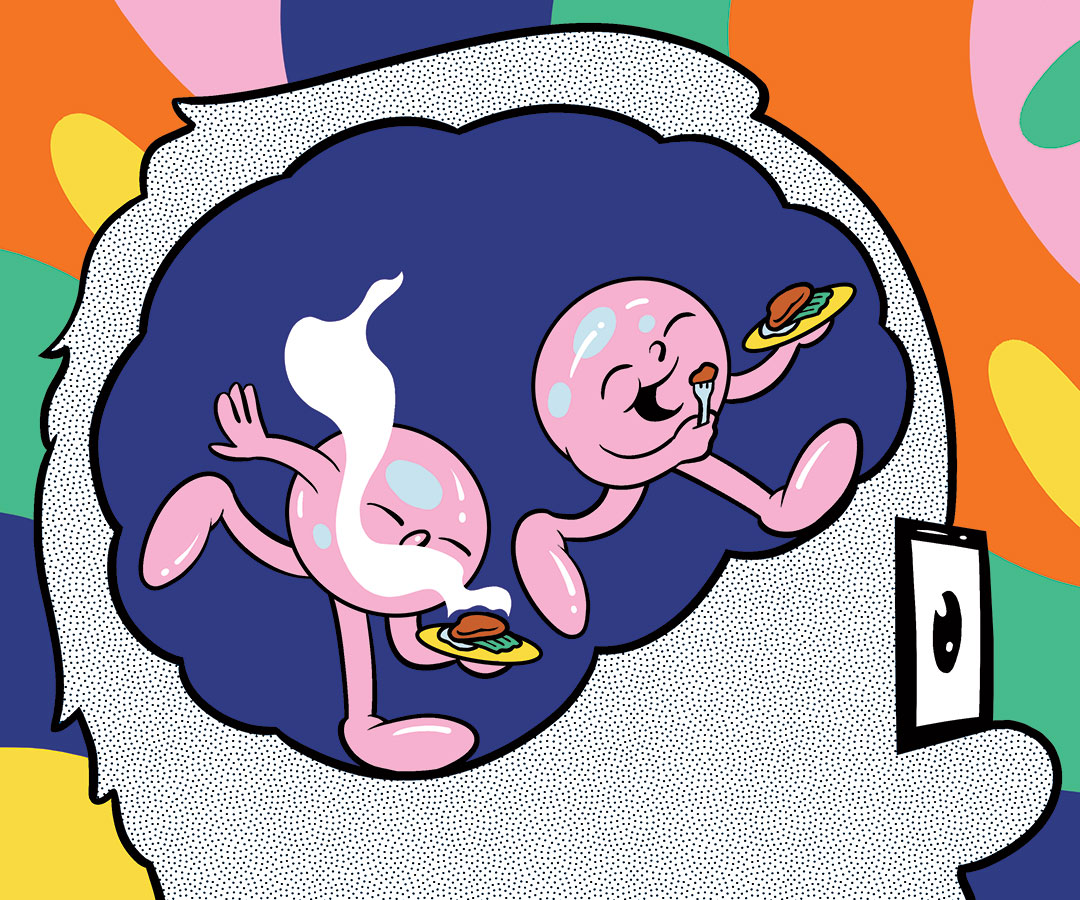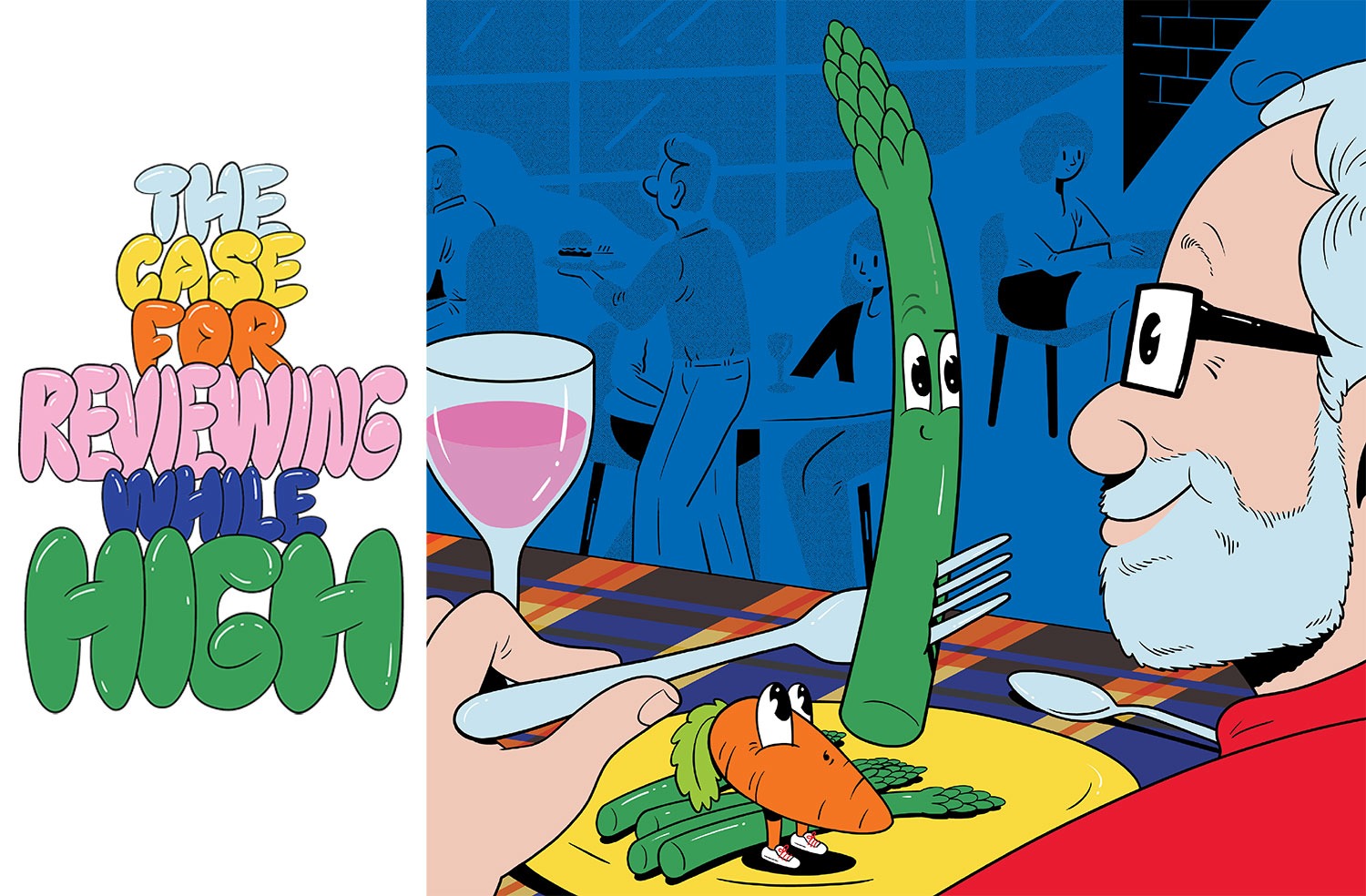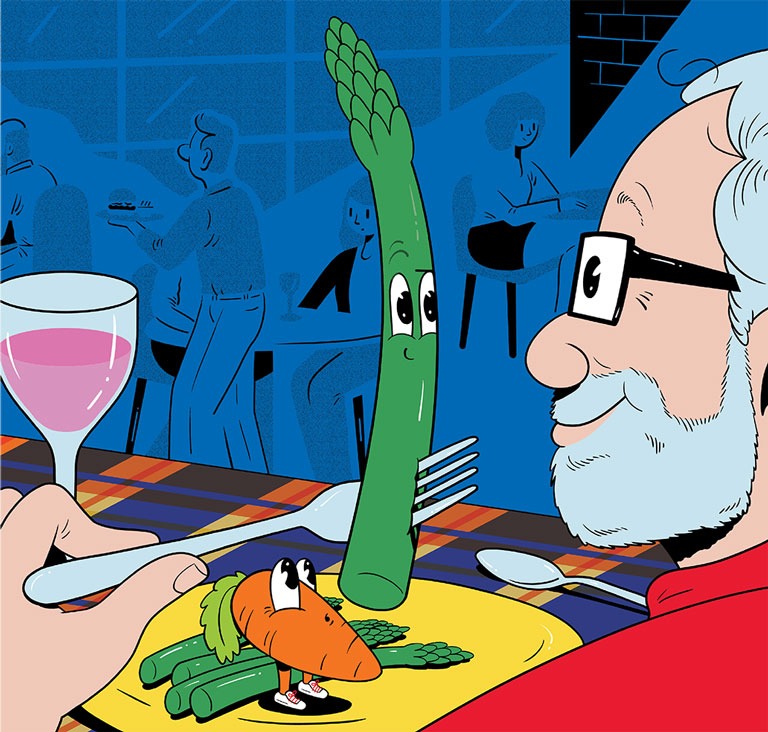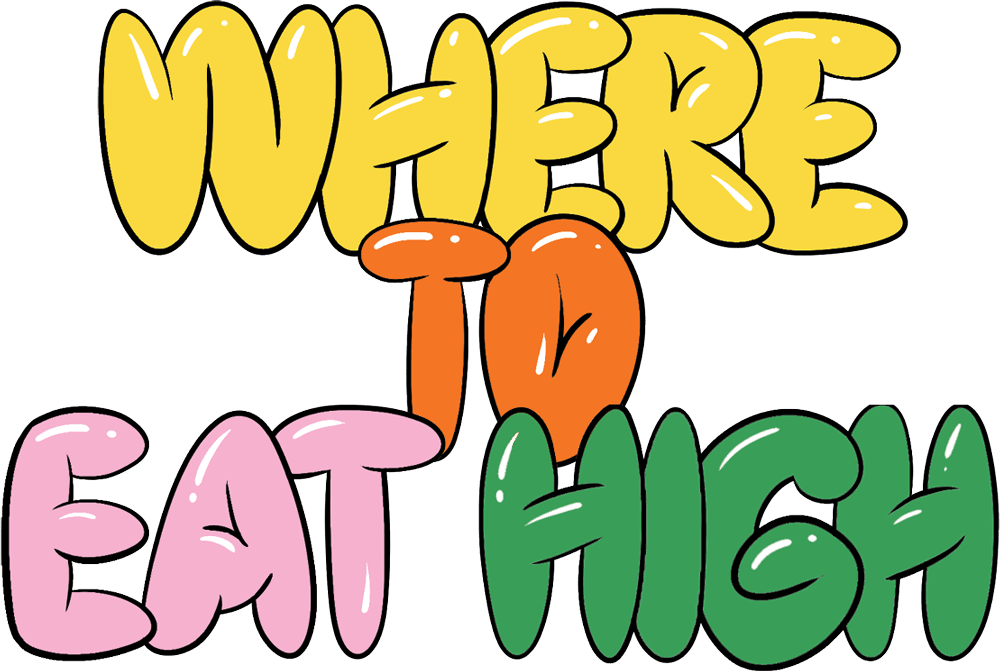
was in the middle of reviewing a three-hour tasting menu when a course arrived that featured house-cultured buttermilk made with cream from Kilgus Farmstead, a local dairy with cachet. It was … vile. Nothing like the good buttermilk I know, which is sweet and grassy and brightly acidic in a way that balances the funk of fermentation. This tasted more like that pint of forgotten half-and-half you dig out of the fridge, sniff, sip-test, and think, Oh God, a mouse died in this.
I began to consider the chemistry of cultured dairy. Lactobacillus: That’s a good kind of bacteria, right? Surely the chef at this lofty restaurant, Feld, purposefully introduced it, perhaps from a freeze-dried starter culture or an earlier batch. So what went wrong? Did some ambient “bad” microorganism find its breeding ground while the milk sat out overnight? Was it stored in the cooler next to some stinky cheeses? What else was in the fridge? Fish? And why was I getting so lost in thought?
Oh right, I was high.
About an hour before dinner, I had consumed a yuzu-flavored gummy containing five milligrams of a sativa-heavy strain of cannabis. I did this very much on purpose because, after decades of experiencing tetrahydrocannabinol’s effects on the act of eating, I know it is about so much more than “the munchies” for me. Sure, THC heightens my appetite enough that I may polish off an unneeded pint of ice cream. But it also makes me acutely aware of smells and flavors. With a little weed in my system, I’m more observant, more open to sensation, and more apt to engage in the dining experience as it’s happening rather than jump to conclusions based on preconceptions. I become more discerning.
Which is why I often choose to be under the influence on one of the several visits I make to a restaurant I am reviewing. Although this may strike some as journalistic malpractice, I maintain that it makes me better at my job.
So I wasn’t mad at that buttermilk. I was curious about it, just as I was about the artichoke that had been grilled so slowly and with such intention that I could feel the whorl of tender leaves collapsing between my teeth if I bit down slowly. Much thought went into this meal, and while the results weren’t always successful, they were worthy of the kind of mindful consideration cannabis allows me to give.

et me ask: How do you describe a dining experience? Perhaps you go down a checklist: The scallops were sweet. The duck sucked. The server was nice enough but never there when you needed them. We all do this, hold our invisible clipboards like we’re DMV inspectors taking the restaurant out for a driving test.
When I review a place, I like to toss the notepad aside and take a broader view. I try to put the restaurant in context: the dialogue it engages in with the rest of Chicago, with national dining trends, with the chef’s life and work. Yet I also want to feel the specific pleasure of spending these hours of my life at this meal. Even if it’s not my scene or my favorite food, I imagine myself as the target guest. If a dopamine hit from the yuzu gummy helps, great.
Additionally, THC affects the brain’s olfactory bulb and can significantly increase the perception of smells, as was suggested by a 2014 study of mice at the University of Bordeaux. Because smell and taste are so closely related, THC ups the sensation of flavors. The drug may cause people to eat more, but it will assuredly cause them to taste more.

THC ups the sensation of flavors, as a French study suggested. The drug may cause people to eat more, but it will assuredly cause them to taste more.
Eiron Cudaback, a neuroscientist who teaches in the cannabis studies program at DePaul University, explained to me how all cannabinoids — both the ones our bodies naturally produce and the ones, like THC and CBD, that we ingest — are lipid molecules that can pass through the blood-brain barrier and affect parts of the brain that induce hedonia (feelings of pleasure) and regulate cognitive function.
But here is where Cudaback draws a distinction that is as fundamental to neuroscience as it is to restaurant reviewing: “Sensation is very different from perception,” he says. The drug affects both: the intensity of what you smell and taste as well as the ways your brain chooses to process these stimuli. The associations, the feelings, and the memories that arise in a stoned mind can be different from those conjured by a sober one but are no less valid.
“Is the machinery affected [by the drug], or is it the way you’re imagining it?” Cudaback asks, adding, “I would imagine in your line of work what’s important is that you can feel [what you’re tasting] and relay it to other people.” Indeed, half my worth as a writer is in telling readers how food tastes, and the other half is in explaining how it hits. THC helps me draw the distinction.
I surprised myself a year ago when I gave a favorable review to La Serre, a West Loop party box with a selfie station, a ton of fake plants, and a shallow South of French theme. It is a fairly frivolous restaurant, but with the help of half a fast-acting Tangerine Twist gummy, I could join in the ambient good times. I could distract the inner snark monster enough to feel the immersive embrace of this plastic setting and let my eyes jump from the table of three tipsy girlfriends, to the double-daters, to the conference-goers still wearing their name tags and psyched to be in a big city, to the eagle-eyed floor manager whispering in the ear of a waiter.
Most important, I could appreciate the quality of the food and how the cooks in each station — grill, sauté, salad — had hit their marks. I could imagine myself behind the line, knowing to take a lidded pot of mussels off the flame just as the shells were ready to pop open and that the steam would finish the job as they arrived at the table. I could relish the fact that the wine I had asked to be delivered with my entrée appeared precisely on time. It’s such a delight when a server gets this one detail right, a virgin glass of cool wine alongside a hot plate of food. Good timing is like music, and dinner is the dance. Stoned revelation, but it’s true, right?
Like many users, I find that THC can quell the judgmental or overly rigid thinking patterns to which I’m prone, as well as the grumpiness that sets in with age like wrinkles on the soul. Paradoxically, being less judgy means being more clearheaded and dispassionate, separating feelings and biases from critical observation. This is because THC suppresses the central nervous system, decreasing the release of transmitters that can affect my mood and cloud my perceptions. In other words, it takes the edge off. So when I find a restaurant not worthy of recommending, the slight tweaks to my brain chemistry help me understand with more clarity why.
When I reviewed Kindling Downtown Cookout & Cocktails, a massive two-story restaurant in the Willis Tower, I could’ve stood stewing in the crowded vestibule while I waited far past our reservation time. Instead, the weed helped me plunge into the front-of-the-house chaos like a mosh pit. I broke away and followed a staffer darting upstairs, seemingly looking for any table that could accommodate us. My review was a fair assessment of this poorly managed aspect, not just a gripe.

toked for the first time with my older brother when I was 11. It made me feel silly, which was and is my preferred state of being. I was young, too young, but it was the ’70s. I bought my first baggie at 12. In junior high school, I led a double life, half freak and half geek, with two groups of friends — stoners and mathletes — that I was always terrified would figure out my duplicity. By high school and college, I had found my people among those who tended to smoke more than drink and favored epic living-room bull sessions over loud parties.
As hydroponics and indoor growing systems became more prevalent in my young adulthood in the 1990s, I began to experience weed-induced paranoia and was often wary of taking more than a puff or two. That and several other factors conspired to make me stop: My wife never used it, our inquisitive oldest daughter entered first grade, and we moved from liberal Colorado to conservative Georgia. A good decade or more passed before I came across an Altoids tin containing two joints hidden in my old turntable in the garage and thought, Huh, I wonder … (Reader: I got a buzz.) After that, I smoked now and again, yet the strength of modern cannabis made me wary. All those new hybrids produced intense reactions — sometimes euphoria, sometimes debilitating social anxiety.
I was a few-times-a-year user when Illinois legalized recreational cannabis in January 2020, just a couple of months before the pandemic. By the time of shelter-in-place, I had discovered edibles. With the right strain and dosage, I remembered what I had most loved about weed — the pleasure it brought to experience. I cooked elaborate dinners every day, the best I had in years, and I never looked at recipes, just ingredients. I went on long masked walks with no destination in mind and fell in love with the city. After the lockdown was lifted, I began taking gummies to see wide-format movies at the Music Box and hear the CSO perform at Symphony Center. Absolute bliss.
After becoming Chicago’s dining critic in 2022, I wrote my first big cover story, on the emergence of high-end sushi restaurants, and one plum assignment was to try the omakase at Kyoten. At nearly $500, this was a meal so expensive that I would have to experience it alone. That seemed like it would be an awkward few hours of pretending to read a book, so I took a gummy.
At one end of the six-seat bar was a local power couple who had asked the chef to hide them behind a kind of privacy screen with their four bottles of grand cru Burgundy. At the other end were a husband and wife about my age with their grown son, who was celebrating his birthday. “He’s the foodie,” said the mom with a smile, rolling her eyes. I made just enough conversation with the family and chef Otto Phan. I tossed my book and my people-pleasing instincts aside and did what I really wanted to do: just be there in the moment and eat. The wild fish Phan served had flavors that came from their diet, and their flesh had more tensile strength from swimming in open seas. Could I figure out a way to communicate these observations to readers in a way that sounded appetizing? The weed would help me get there.
The gummy kicked in with the first course. I had a blast with the high-concept presentations, but many of the flavors felt off to my palate. Sweet potato ice cream had an icy texture that made the caviar on top taste metallic.
I had another extravagant solo meal while high at Esmé a few months after it opened. That whole “edible work of art” concept is no mere metaphor here, since chef Jenner Tomaska collaborates with a local visual artist as he carefully considers everything from the sculptural dishware to the heritage flavors and seasonings. The gummy kicked in with the first course. I had a blast with the high-concept presentations, but many of the flavors felt off to my palate. Sweet potato ice cream had an icy texture that made the caviar on top taste metallic. A patty of minced meat served on a ceramic bone was witty, but its sticky sweet sauce gave me an unfortunate association: It was an haute McRib.
If I hadn’t been high would I have been less put off by the flavors?
Not necessarily, because here’s the thing: Being high is the litmus test. If I’m feeling more open to pleasure, more forgiving of errors, more engaged with what’s around me, and less prone to curdling into peevishiness and the restaurant still doesn’t make me care about it, then I have my answer: The meal wasn’t good.
When all your neurotransmitters are firing, time tends to slow down as you process the shifting feelings, and that’s a good thing in my line of work. It helps me dial into an indelible moment. One sunny day I took a gummy and went for a walk on the 606. On the way home, I passed by Red & White, a Bucktown wine shop and bar, and decided to stop in for a glass. I can’t remember what I ordered, other than that it was a light-bodied red from France served chilled. I felt like I could taste the winemaking — the way whole clusters of sun-warm grapes went into a stainless steel tank where wild airborne wild yeast alighted, causing the grapes to swell and pop, releasing so much carbon dioxide into the air you could hear it buzzing if you were there. The winemaker pressed this juicy must to rid it of skins and stems until nothing but a pellucid ruby ferment remained — a simple wine, bottled and shipped all over the world, arriving in Chicago for me to have the privilege of drinking it on this lovely, sun-slanting evening.
Was that the weed talking? Maybe, but that’s why I eat and drink, and that’s why I write.





